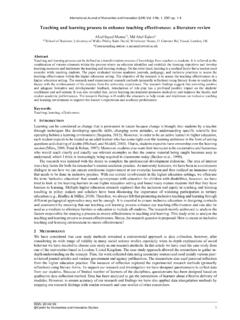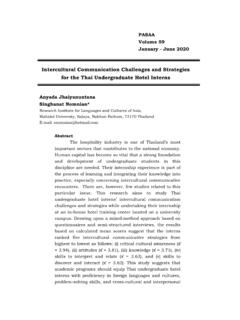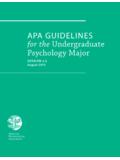Transcription of Language Teaching Methodology and Second Language …
1 UNESCO EOLSSSAMPLE CHAPTERSLINGUISTICS - Language Teaching Methodology and Second Language Acquisition - J. Mihaljevic Djigunovic, M. Medved Krajnovic Encyclopedia of Life Support Systems (EOLSS) Language Teaching Methodology AND Second Language ACQUISITION J. Mihaljevic Djigunovic and M. Medved Krajnovic Department of English, University of Zagreb, Croatia Keywords: Teaching grammar, Teaching vocabulary, Teaching literature, Language learning skills, Language for specific purposes, syllabus design, classroom interaction, aptitude, attitude, motivation, anxiety, communicative competence, strategies, interlanguage, contrastive analysis, error analysis, the age factor, crosslinguistic interaction, variation, fossilization, input and interaction, generativism, interactionism, emergentism.
2 Contents 1. Introduction 2. Language Teaching Methodology Historical overview of foreign Language Teaching (FLT) methods The present Content of Language Teaching Teaching Language skills Syllabus design Materials development Language assessment The Language classroom The Language learner Language teacher competences 3. Second Language Acquisition (SLA) SLA: definition and goals Historical overview of SLA research Current research issues The current state of SLA theories and research methods Glossary Bibliography Biographical Sketches Summary The first part of the article focuses on Language Teaching . After a historical overview of foreign Language Teaching methods, the key issues in Language Teaching are outlined.
3 A special section is devoted to communicative Language Teaching , the current approach to foreign Language Teaching , and two important aspects that reflect tendencies in modern Language pedagogy: learner-centeredness and use of information technology (IT). This is followed by sections on the content that is actually taught ( pronunciation, grammar etc.), on Teaching the four foreign Language skills, role and types of Language syllabi and Teaching materials, and the issue of Language assessment. The rest of the first part looks at Language Teaching from different perspectives: those of the Language learner, the context of learning (the Language classroom) and the Language teacher. UNESCO EOLSSSAMPLE CHAPTERSLINGUISTICS - Language Teaching Methodology and Second Language Acquisition - J.
4 Mihaljevic Djigunovic, M. Medved Krajnovic Encyclopedia of Life Support Systems (EOLSS) The Second part of the article is devoted to Second Language acquisition (SLA). Following the definition and the goals of this new discipline within applied linguistics, the authors offer an overview of its development throughout its relatively short history that traces it back to the times of contrastive analysis and error analysis. The section on current research issues offers also an insight into recent interests and foci of Second Language acquisition experts. The last section focuses on SLA research Methodology and current SLA theories. 1. Introduction Foreign Language Teaching (FLT) and Second Language acquisition (SLA) are two subfields of applied linguistics that are quite different in historical and research terms.
5 For a large part of its long history FLT relied mostly on intuitive approaches of both theoreticians and practitioners. Nowadays, Language Teaching draws heavily on insights that are validated by the research into the Teaching process in all its complexity. The content of Language Teaching ( vocabulary, grammar), its aims ( communicative competence), its protagonists ( learners, teacher) as well as elements of the process itself ( Language learning and acquisition, classroom interaction) have each contributed to and benefited from a number of disciplines that focus, exclusively or in part, on this imortant human activity. With a recent insistence on learner and the learning process, FLT is slowly beginning to be informed by SLA, a discipline that studies Language learning as a uniquely human, cognitive process and can potentially offer a better understanding of the very nature of the human mind and intelligence.
6 Although SLA researchers generally consider applied aspects of their research to be of secondary importance, the revelance of their findings in such areas as age constraints, crosslinguistics interaction, and the role of input etc. is undeniable. It may be fair to say that FLT and SLA can contribute much to a better global understanding of the human nature and to a further development of intercultural communication. 2. Language Teaching Methodology Historical overview of foreign Language Teaching (FLT) methods Language Teaching Methodology has gone a long way from being based on dogmatic beliefs about the only good way of Teaching to being based on insights into processes of Second Language acquisition and the dynamics of the Language classroom itself.
7 First conceptualizations of Language Teaching were based on Teaching Latin. From the sixteenth century onwards European vernacular languages came to be studied as foreign languages (FLs) too. Once they became school subjects they were taught in the same way as Latin by the grammar-translation method. The grammar-translation method was the dominant method for many centuries and was best exemplified by the formal Teaching of the classical languages (Latin and Greek). Language analysis, memorizing paradigms and complex grammar rules in order to be able to read and translate literary texts and to learn to write similar texts were supposed UNESCO EOLSSSAMPLE CHAPTERSLINGUISTICS - Language Teaching Methodology and Second Language Acquisition - J.
8 Mihaljevic Djigunovic, M. Medved Krajnovic Encyclopedia of Life Support Systems (EOLSS) to train the mind of the student. The FL was hardly ever used in class and no Language communication skills were developed. By the end of the nineteenth century opposition to the grammar-translation method became very strong and got articulated in a number of new methods. Their common philosophy was based on the belief that a Language is learned by direct association of foreign words with the objects and actions they denote and not through the mother tongue. The new methods were called by the common term - the direct method. Insistence on the FL as the medium of instruction and the development of phonetics as a discipline at the time stimulated the importance of pronunciation.
9 Grammar was taught inductively, which made the student an active participant of the Teaching process. It was also taught functionally, that is the choice of the grammar structures taught depended on what was used most frequently in speech. Speaking preceded reading, and reading was dealt with so as to encourage guessing meaning from context. Some experts consider that having the student active was the most important advantage of the method. A number of modifications on the direct method throughout time kept it alive for a long time. Originating in the United States, the reading method was based on the pragmatic assessment of what could really be mastered during the short, usually two-year period that learners on average spent learning FLs.
10 Language Teaching experts concluded that the most a learner could be expected to do was develop an ability to read and understand texts in the FL without having to translate. They believed that mastering the reading comprehension skill to a certain extent would enable learners to go on learning by themselves. However, the method was mostly used in Language courses that were too short to equip learners with enough Language competence to manage authentic reading texts. With the rapid development of technnology, social changes and new communication needs in the 1920s and 1930s, the oral skills took precedence over written skills. The method that appeared at the time 'the audio-lingual method' - was based on and inspired by insights developed by structural linguists ( L.)














